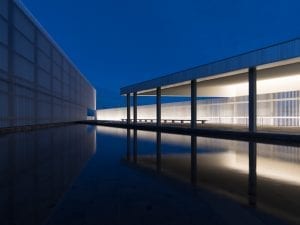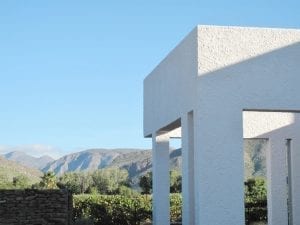Profiling the announcement of the annual awards through a celebration of structural excellence that pushes beyond aesthetics and functionality.
In her dazzling book, Architecture from the Outside, feminist theorist Elizabeth Grosz (b. 1952), who is most known for pioneering work on the body, makes the deceptively simple point that “outside architecture is always inside bodies, sexualities, history, culture, nature”, factors that she calls the industry’s “constitutive edges.” The point here is that whilst history, culture, politics, nature, desire and our bodies shape buildings, so too are these aspects of our lives shaped by the spaces we traverse and inhabit. Good design, then, has a profound impact on the kind of societies which we build. The annual RIBA Awards are a barometer for outstanding structural work in the UK, with a record of recognising the most innovative and successful projects. In anticipation of the 2018 selection, Aesthetica speaks to Julia Barfield, an Awards Assessor for RIBA and Director of Marks Barfield Architects.
Barfield and her firm have won more than 60 awards for their design, innovation and sustainability, including being named “Architectural Practice of the Year”, winning a Queen’s Award for Enterprise & Innovation, and being shortlisted for the title of Woman Architect of the Year. In Barfield’s opinion, the RIBA awards are “the gold standard of what constitutes good architectural practice”, and that recognising this fact has a social significance for communities across the nation.
“I believe that good design has a beneficial effect on people’s lives. Whether seen in public spaces or in relation to specific private buildings, architecture is something which people interact with on a daily basis, both users from the inside and passers-by. It’s really important that people understand that design isn’t all about the way things look on the outside, it’s also about the way things interact with their context and add to their neighbourhood, and the way it can lift people’s spirits as they move through a space.”
The Awards are realised through a pyramid structure, which has been developed to reward outstanding practice at various different levels. There are Regional Awards, National Awards and then there are a handful of buildings which are chosen to go forward for the Stirling Award title. As Barfield comments: “This methodology is a way of rewarding as much best practice as we can, and recognising quality at a local and national level. There is also Client of the Year. The latter is sometimes overlooked but it is really important because you can’t get a good building without working with someone who is on the same page.”
The winner of the 2017 Stirling Prize was Hastings Pier, a community-led regeneration project that caught the judges’ and the public’s imagination: a highly innovative and contemporary take on the exterior architecture of a pier. The space was designed by London-based architectural firm dRMM, and, unlike more familiar 19th century structures, is characterised by its use of free and open interiors. It is a kind of public platform or forum which is suspended over the sea. As such, it is almost an invitation for the pier to be about the potential for its users to reimagine and reconstitute the significance of a pier for them, for their own time and place.
This user-centred approach is an important part of the assessment criteria. As Barfield notes: “The judges consider how buildings make people feel. We spend the majority of their lives inside. Well-designed housing means lots of natural light, that they enable views out, that there is a good relation between inside and outside, that the circulation is clear, so that people instinctively know where they are. Also, the fact that structures will last and are sustainable.”
Amongst the projects on the shortlist for the 2017 RIBA Awards was Barretts Grove, a striking housing development in Stoke Newington by Amin Taha + Groupwork. It has a magical aura, which is unsurprising, given its construction out of the visceral and emotive materials of brick, wood and straw. It is tall and narrow, as if the structure is squeezing against the wall at a party to avoid taking up too much space, and its most charming features are the wicker balconies that each apartment has. This building has drama, usability, and interacts with its neighbourhood (which includes a nearby primary school) in exciting, comfortable, unexpected ways. It feels like one house which has been divided into individual apartments and this element helps to build a sense of communality and sociability. With the pressures of the housing shortage starkly apparent in the UK, Barfield makes the point that housing solutions are one of the areas the RIBA Awards are always interested in.
Another area of architecture that Barfield is excited about this year are the transformations taking place in attitudes in the business sector, with companies recognising the importance that workplace design has regarding the ethos, productivity, and overall working environment. “In the last few years workplace design has become hugely exciting because multinational companies recognise that their most valuable asset is the people. There is a clear understanding that the quality of the working environment affects retention of staff, and whether employees are happy to come to work and able to give their best. There is the same profound effect in educational institutions, from primary schools right through to higher education. The capability of buildings and the spaces surrounding them have a great impact on people’s well-being and overall learning.”
In the 2017 Stirling Prize Shortlist, the vast new City of Glasgow College Campus by Reiach And Hall Architects and Michael Laird Architects was recognised for its user-friendliness. The area’s sheer scale, bringing together facilities and teaching which was previously housed in 11 separate buildings across the city within two new central campuses, is remarkable. However, given its immensity, what is most inspiring about the space is how clear and directly it communicates itself as a place that values learning, with a commendable restraint in the materials and fabric used. This isn’t a campus that elevates convolution in design; it is a project that facilitates education – something which cultural theorist Bell Hooks describes as “a practice of freedom.”
Of course, the diversity of structures which have been put forward for the RIBA Awards makes the judging process a balancing act, as Barfield remarks: “Some might be quite simple, and some might be much more complex. All buildings are unique: each site is different; each brief is different. In judging, we have to assess the architectural ambition and ideas, the sense of vision in the design, and also innovation. As the RIBA panel, we are progressive, and therefore we should recognise those people who are trying to push the profession forward in an innovative way, and whose work is characterised by invention and originality.”
In some projects, originality goes hand in hand with an appreciation of history and tradition. These qualities can certainly be seen working together in Command of the Oceans at Chatham Historic Dockyard, by Baynes and Mitchell Architects, which was shortlisted for the 2017 Stirling Prize. This project rejuvenated the site through taking a progressive and sustainable approach to a programme of regeneration. A new visitor centre entrance demonstrates a clear interaction with, respect for and understanding of, the historic fabric of the work. The materials chosen for the scheme have been rigorously researched in order to complement and engage with the existing structure as well as connect with the historical dimension of acknowledging its past uses. Simultaneously the building has both modesty and generosity. What one notices about the edifice are the historic elements, and yet the new development makes these more accessible, usable and easy to navigate.
This concept is known as “fitness for purpose” and is an important aspect of the assessment criteria. This particular concept concerns how architects have responded to its brief, and, ultimately, what the client thinks. Another example from the 2017 shortlist that can be regarded as being fit for purpose is the British Museum’s new World Conversation and Exhibitions Centre, by Rogers Stirk Harbour and Partners. This building houses further exhibition galleries, as well as providing space for a series of “behind the scenes” activities essential to the working of the museum, such as laboratories and conservation studios, storage, and facilities for the logistical requirements and loans programme.
The relation of the building to its brief is particularly challenging in this case, given the spatial demands of the site, and the iconic status of the museum itself. The project also had to respond to particular objects that might be exhibited in the gallery, and which could not be shown elsewhere. Light, temperature control, pest avoidance and other aspects were also vital to how this example met its challenging and complex brief, given the sensitive nature and high value of the objects which would be housed here.
The final project on the 2017 Stirling shortlist was by 6a Architects for Juergen Teller, the internationally renowned artist. The brief was to create a photography studio on a site in West London’s Ladbroke Grove that is currently given over to mainly industrial buildings. Since the site doesn’t allow for far-reaching views out from the studio, the designers came up with an innovative plan for networked courtyard gardens that allow for natural light. The attention to detail and sheer quality of the design is what distinguishes this project, with all the elements carefully chosen and combined. The use of in-situ concrete makes a gorgeously abstract form for stairs, which are complemented by seamless brass balustrades; whilst large timber window frames add a special sense of character and warmth to the modern structure.
The variety of RIBA’s 2017 shortlist is a testament to the wide range of cutting-edge and progressive architectural works which are being carried out in the UK. The 2018 roster of schemes submitted for consideration is sure to be similarly diverse and exciting. In Architecture from the Outside, Elizabeth Grosz asks the question: “How can we understand space differently, in order to organise, inhabit, and structure our living arrangements differently?” The RIBA Awards, as well as recognising excellence in the profession, play their own significant part in how architects in the UK go about continually answering and revising their answers to these social, political and cultural questions for all of us.
Words
Colin Herd










